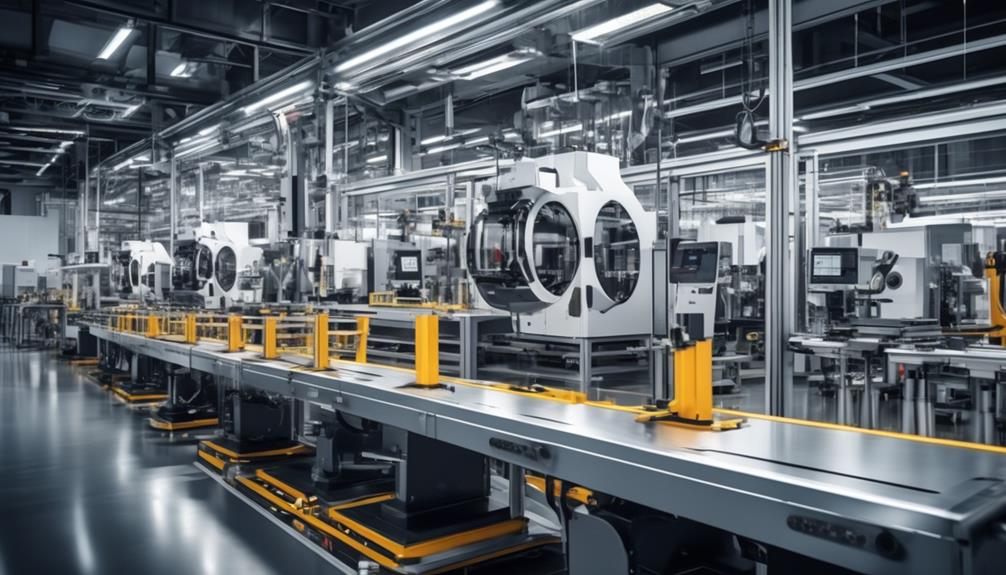Automating quality inspections in manufacturing processes is proven to boost productivity. Interestingly, these inspections can decrease defects by up to 90%. This innovative advancement has attracted the attention of many industry leaders.
But what exactly are these systems and how do they work? Well, let's explore the intricacies of automated quality control systems in manufacturing and uncover the impact they're having on the industry.
Key Takeaways
- Automated quality control systems in manufacturing ensure efficiency and effectiveness of manufacturing processes.
- These systems improve the accuracy of defect detection, leading to enhanced overall product quality.
- Implementing automated quality control systems reduces quality control costs and increases competitiveness in the manufacturing landscape.
- These systems enable high rates of inspection, improving productivity by increasing throughput and providing dynamic, real-time reviews of production quality.
Importance of Automated Quality Control
Automated Quality Control plays a pivotal role in ensuring the efficiency and effectiveness of manufacturing processes. By integrating automated quality inspection systems into the production process, we improve the accuracy of defect detection and ensure that issues are identified before they escalate, reducing quality control costs and enhancing overall product quality.
These systems not only streamline the inspection process but also increase throughput, allowing for a faster and more efficient production cycle. The importance of automated quality control can't be overstated in today's competitive manufacturing landscape. It not only improves the competitiveness of a company but also ensures that products meet the highest standards, ultimately benefiting both the manufacturer and the end consumer.
With automated quality control systems in place, manufacturers can proactively identify and address potential issues, contributing to a smoother and more reliable production process. In essence, these systems are instrumental in maintaining high standards and driving continuous improvement in the manufacturing industry.
Difference Between Manual and Automated Inspections

When comparing manual and automated inspections in manufacturing, the error-free nature of automated inspections stands out as a significant advantage over manual methods. Automated inspections eliminate human error, ensuring the overall product quality and reducing potential issues. Below, we present a comparison table highlighting the key differences between manual and automated inspections:
| Aspect | Manual Inspections | Automated Inspections |
|---|---|---|
| Human Intervention | Relies solely on human observation | Involves no human involvement except for loading and unloading |
| Inspection Rate | Prone to causing bottlenecks due to slower rates | Enables high rates of inspection, improving efficiency |
| Customizability | Limited by human capabilities | Customizable, using advanced technologies like robot-mounted optical CMM or 3D scanning CMM |
| Application Scope | Prone to human error and inability to inspect every single part in high-throughput environments | Used for various applications, ensuring comprehensive inspections |
Automated inspections offer advanced quality control solutions, integrating vision and data analysis to enhance the efficiency and accuracy of inspections.
Benefits of Automation in Quality Control
Improving efficiency and accuracy, automated quality control systems offer numerous benefits in manufacturing. These systems play a crucial role in enhancing production quality and streamlining the quality control process.
The benefits of automation in quality control include:
- Reduced Costs:
- Automated quality control systems help detect issues before they escalate, reducing quality control costs and enhancing overall product quality.
- By eliminating human error, these systems enable high rates of inspection, leading to cost savings and improved competitiveness in manufacturing.
- Enhanced Productivity:
- Automation in quality control improves productivity by increasing throughput and providing dynamic, real-time reviews of production quality.
- This not only reduces staffing issues but also contributes to increased business growth.
- Improved Reliability:
- Automation eliminates human error, improving inspection measurement reliability.
- Automated quality inspections provide consistent and accurate results, contributing to the overall reliability of the quality control process.
These benefits highlight the significant advantages that automated quality control systems bring to manufacturing, making them an essential component for companies striving for excellence in their production processes.
Business Advantages of Automated Inspections

With automated inspections, businesses can achieve improved productivity and optimized measurements, leading to enhanced overall performance. Intuitive and easy-to-use systems reduce staffing issues and increase business growth.
Automated quality control systems decrease total quality control costs and the costs of quality, ensuring dynamic, real-time reviews of production quality. By implementing automated inspections, businesses can enhance product quality through reduced errors and faster development processes. The advantage of automated inspections over manual quality control on the production line is evident in the reduction of human error and the consistent, reliable assessment of parts.
These benefits result in streamlined operations, reduced waste, and ultimately increased profitability. The ability to quickly identify and address quality issues at various stages of the manufacturing process ensures that products meet or exceed customer expectations.
Choosing the Best Automated Quality Control System
The transition from realizing the business advantages of automated inspections to choosing the best automated quality control system involves careful consideration of the current inspection process, thorough exploration of available systems, and consultation with automated quality control specialists.
- Assess the Current Inspection Process: Evaluate the existing non-automated quality control system to identify its limitations and areas prone to human error. This will help in understanding the specific requirements for an automated quality control system.
- Research Available Systems: Conduct extensive research on automated quality control systems, considering factors such as their ability to inspect a wide range of manufacturing and packaging components, integration with Web Development, and their track record in helping companies and industries achieve high-quality products.
- Consult with Automated Quality Control Specialists: Seek guidance from experts in the field who can provide insights into the best-fit automated quality control system for the specific manufacturing processes, ensuring that it aligns with the organization's goals and quality control needs.
Frequently Asked Questions
What Is Automated Quality Control in Manufacturing Processes?
Automated quality control in manufacturing processes is a crucial aspect of ensuring product integrity. It involves the use of advanced technology to detect and address issues before they escalate.
Automated systems streamline inspections, reduce costs, and enhance overall product quality. They outperform manual inspections by eliminating human error and increasing inspection rates. These systems boost throughput, improve competitiveness, and are essential for various manufacturing applications.
What Is QC Automation?
We define QC automation as the process of utilizing automated systems to inspect and assess product quality in manufacturing. It aims to detect issues early, reducing costs and improving overall quality.
Automation eliminates human error, enabling high rates of inspection for various applications. It enhances decision-making by capturing more data and providing real-time reviews.
What Are the 4 Types of Quality Control?
We implement several methods in our processes to ensure high standards and customer satisfaction:
- Statistical Quality Control: We use statistical techniques to monitor and control product quality.
- Acceptance Sampling: This method allows us to inspect sample batches and make informed acceptance or rejection decisions.
- Continuous Improvement: We are committed to ongoing quality enhancements through continuous improvement efforts.
- Total Quality Management: We follow a comprehensive approach to improve customer satisfaction and organizational processes.
These methods work together to ensure that our products meet the desired standards and achieve customer satisfaction.
What Are the Examples of Quality Control System?
Examples of quality control systems include:
- Statistical process control (SPC)
- Six Sigma
- Total Quality Management (TQM)
- Lean Manufacturing
These systems enable us to monitor and improve production processes, ensuring consistent quality and minimizing defects.
SPC uses statistical methods to analyze variation, while Six Sigma focuses on minimizing defects.
TQM emphasizes continuous improvement, and Lean Manufacturing aims to eliminate waste and improve efficiency.
Conclusion
In conclusion, automated quality control systems in manufacturing are the unsung heroes, silently working behind the scenes to ensure the perfection of products.
Like vigilant guardians, they tirelessly monitor and inspect, eliminating errors and ensuring consistency.
Their presence allows human workers to focus on more intricate tasks, leading to enhanced efficiency and competitiveness.
As the manufacturing industry continues to evolve, these automated systems will undoubtedly play a pivotal role in shaping its future.









